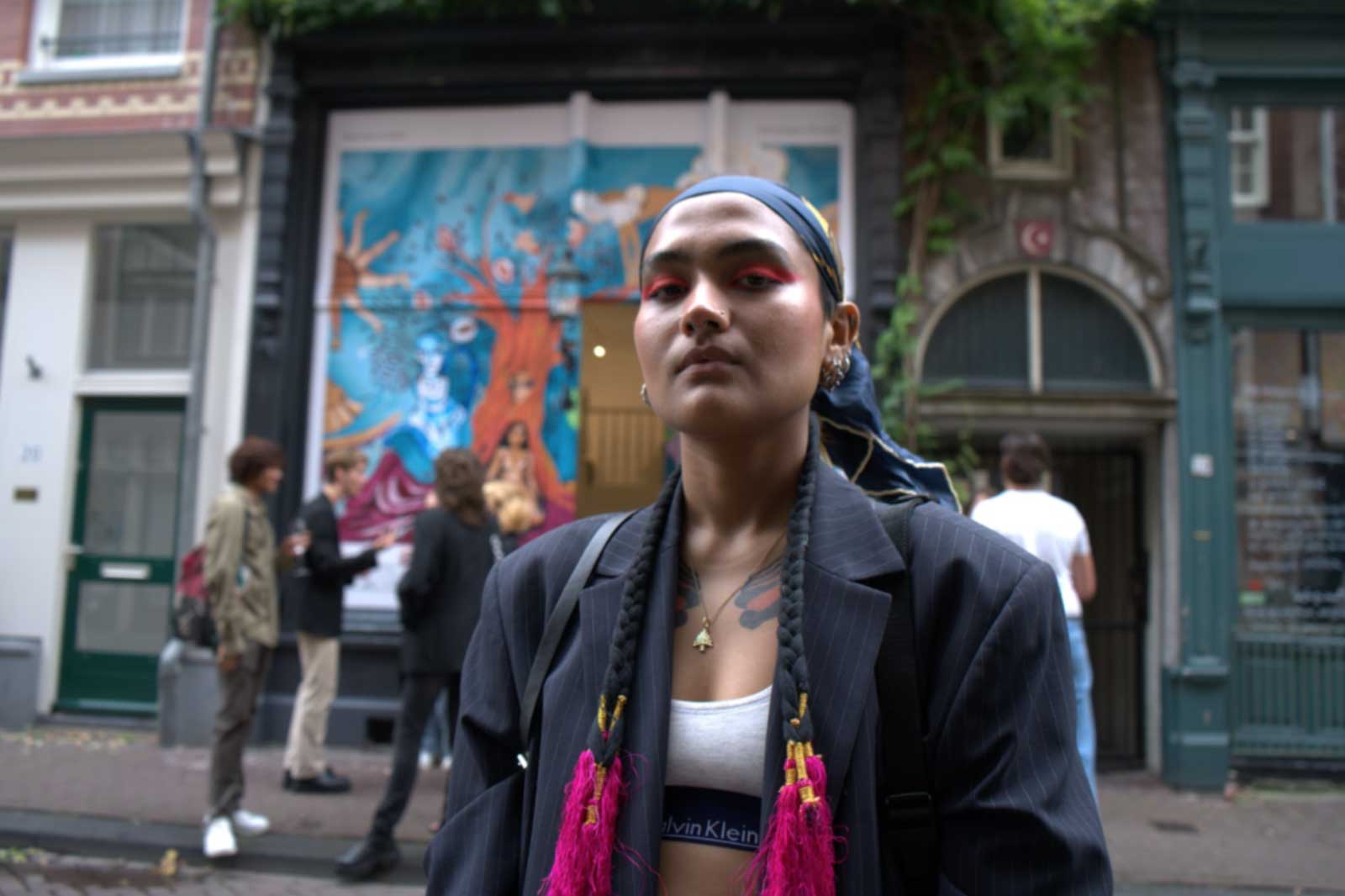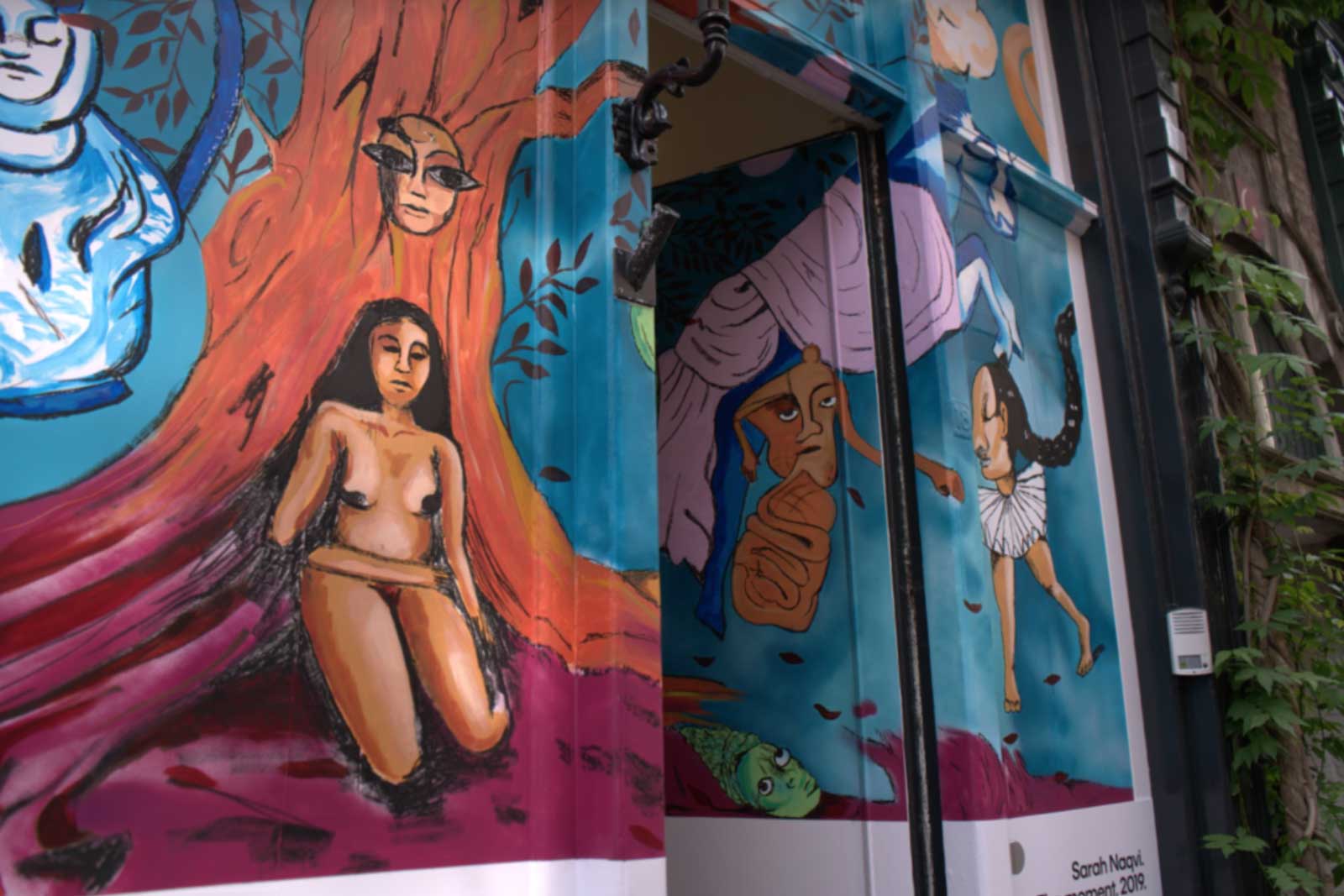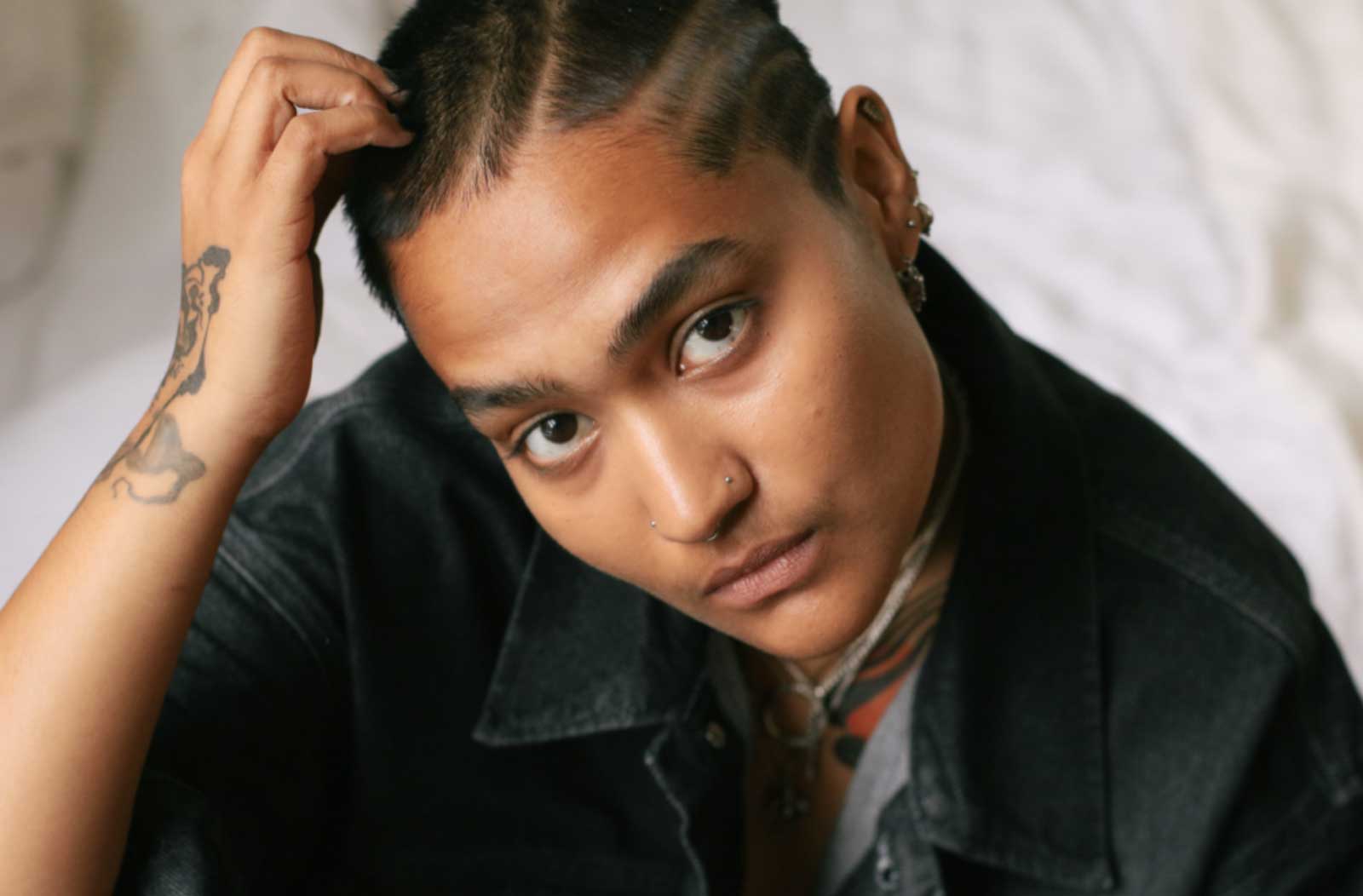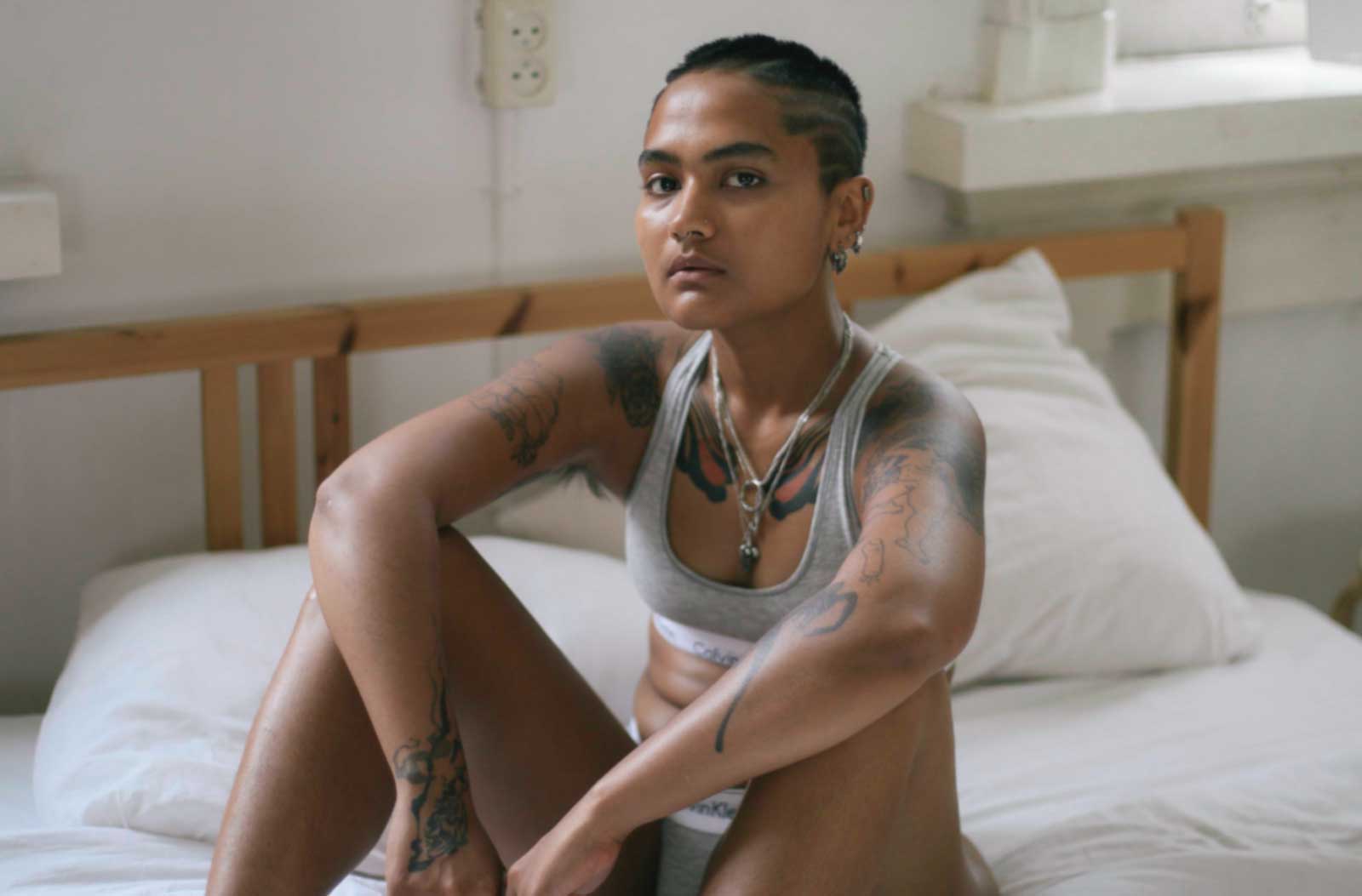Art, activism and gender performativity

Calvin Klein’s year-round Pride campaign just got a whole lot more intimate. Continuing to shine the #proudinmycalvins beacon of light, their latest project ‘Defining Moments’, is a collective investigation into the individuals provoking change across the world. Championing those who convey radical acceptance, love and compassion, the campaign features global icons including Arca, Honey Dijon, Kai Isaiah Jamal, Omar Ayuso and many more. Providing us with an enlightening glimpse into these momentous minds, these Queer Icons have come together to exemplify what we hope the future to reflect.
As part of Calvin Klein’s Defining Moments, a new (and vivid) mural project is in store: a collaboration with four artists across Europe who have been set the task to visually express, through their chosen creative medium, their personal defining moments. Upon hearing that one of the murals will be exhibited in no other than our hometown of Amsterdam, we were excited to get the opportunity to talk with the exceptional talent, Sarah Naqvi: a contemporary artist whose work covers themes such as gender, sexuality, race, religion and body positivity. Discussing their craft, artistic journey, relationship to the community and personal moment: a “rare conversation” with their family about queerness, it was an overall eye-opening, and riveting interview which we are honoured to share.
Hi Sarah, thank you for taking the time to answer some questions! Could we begin with how you first found art and the ways in which your craft has developed from this point?
I chose to do my Bachelors in Textiles at NID because that was the most logical way to pursue a creative profession (and one that provided stability and security according to my family). I, however, always wanted to be an artist. I think I now realise that this would come to me in literally any form. Instinctually, I felt drawn to music, materials and anything that gave me space to explore beyond the traditional ways of learning a skill. Textiles was the most natural transition into being an artist because of my family’s tradition and background with stitching and embroidery.
A vehicle to the broader spectrum of the possibilities of art. How did you begin sharing your work?
I started using my Instagram to post work and the progress it entailed, all while I was still in college and it felt incredibly rewarding to have an archive available to understand the process of how a work comes into being. It’s like being inside the artist’s head and that is a true privilege. I felt a lot of conflicts initially, some back and forth with the medium itself but I think at the end of the day, to be accessible to an audience online has also helped in democratizing the way we consume art and not keeping it exclusive to gallery spaces and institutions.
Instagram in many ways destabilises the traditional hierarchies of the ‘art world’. How do you engage with the medium today?
Art requires time and retrospection and an instant reaction is not doing justice to the labour and thought put in. The beauty of the platforms to share art is quite varied; whether physical or virtual, some are more exclusive than the others, but they are all means of communication and for my practice that is instrumental. My practice engages in conversations that centre art as the tool for activism and amplifies the fight against existing realities. I firmly try to create in ways that make my practice feel like an extension of myself, that which does not exist in isolation, that which constantly critiques the systems of oppression and advocates for democracy and freedom of speech.
This intention is so clear within your work, what have you found the most effective way(s) to translating this message to a wider audience?
The materiality and techniques in the work are at play to create familiarity with the viewer, with satire, whimsical props, and softness you are made to believe something joyous awaits. Once these thematics are established and make one comfortable, the visuals are then layered with brutal truths scripted based on prominent sociopolitical developments in the country. I primarily work with textile, embroidery and found objects and have a keen interest in puppetry. There are conscious decisions I make in using these mediums as they have been important in challenging visibility amongst ‘domestic’ art.
It’s about curating a journey in which the audience will inevitably experience upon viewing your work? How have you found this transfer has been perceived with a wider circle?
The nature of the work disturbs and hence has been subjected to anger, and met with resistance, but in any functioning democracy, criticism is valued. Except now, it’s not always ‘criticism’ but a silencing of any voice that stands against the state.
A detrimental (and scary) byproduct of the range of individuals that social media accumulates.
Thoughts that now cross my mind while making are increasingly in fear of my own safety.

For this project with Calvin Klein, you have been named as one of their ‘Queer Icons’, what does this title mean to you?
This is a tough one, as I don’t really see myself as an icon… but I imagine when someone comes to a point in their journey of self-expression, where they directly or indirectly encourage others to start their own, that can be incredibly iconic.
I think we are sometimes scared of terms like ‘iconic’, however, your work, power, voice and radical honestly equate to said title. Who do you see as your fellow icons within the community?
Growing up I didn’t really have those icons to look up to because of how much was kept from me- both as a tool of protection and to ensure I was not given a chance to know of Queerness. This took away the chance to feel and see beyond the confines of my parental upbringing and their belief systems. Somehow I think as a child, I found Queerness without having the words for it, in beauty, in resilience, in the absurd, the mundane and the breathtaking bounty of nature. Today I think I’m surrounded by so many icons that inspire me to do just about anything; get out of bed on a bad day, try to fight systems of oppression… even if it seems like the biggest task to take on I don’t feel like I’m doing it alone. The sense of community and family that I feel is in knowing that there is no final point in liberation for a Queer future till every structure has been dismantled. I look up to many people from the community, but my love for people working at the grassroots of the community transcends any public figure.
Working towards this liberation, and Queer future, who do feel is helping dismantle the binding state the world seems to be inhabiting?
There are so many organisations that I look up to back home in India; Equality labs, Dalit Queer Project, Trans Community Kitchen, and The Queer Muslim Project, just being some of them. There’s also one person whose words bind and free me every time they write, Vqueeram’s words have been light and day since I first found them.

Would you describe your process of creativity as a therapeutic act for both yourself and those who consume it?
My process of making work is now so intertwined with the way I present and provide for myself if that makes any sense?
Definitely.
For most of my life, I have performed femininity. So much so that it felt like second nature. When I finally came to understand that I was non-binary, my performance of femininity did not feel taxing the way it did before, It finally felt like an option. Being socialised as a girl, I embodied so many selves that I felt distant from who I was, these performances felt integral to the way I spoke of my history of becoming so I kept them a part of my process. Gender is a performance that we all have come to adapt to, to the point where it doesn’t feel out of the ordinary: my work grapples with themes of dissent, disobedience and it only fits that a caricature of the most objectified form is re-appropriated to narrate its politics.
And how has this actualisation of identity and the complexities of genders performative nature affected your craft?
The way that this has affected my practice is that it allows me space to explore without being categorised and that truly is cathartic.
The pieces you share with the world are often multi-disciplinary in nature; a creative- yet informative- sculptural canvas. What inspires such momentousness, spanning the many mediums of artistry?
Because I started out my journey in textiles and craft, working with artisans (most of whom had a vision for their practices that none of us could ever comprehend) I realised was the only times I saw individuals becoming one with the medium that they celebrated in their work. In due time I realised I had to take a step back and re-evaluate whether I wanted to work with traditional mediums; forms that continue to be exploited by upper classes with little to no benefit to the actual practising community.
How have you come to find peace within this conflict of the medium?
I now manipulate and distort the textile whilst refusing its limits; the nature of the fabric is a song for me, I just believe it needs to be sung by someone who can respect its form and capacity. The mediums I have come to use in my work have come about after I abandoned the idea that it needs to generate social value as capital, but rather by the stories it can transcend through generations, documenting our ongoing struggles, archiving them for the future to learn from. Each form is driven by my own understanding of it, not by the traditional structured ways of practising it. That automatically gives me the courage to work with it, because I have no pre-existing expectations for it.

Art is an act of storytelling. Sharing our narratives, journeys and struggles with a wider audience. Do you envision the story of a piece prior to its process of creation?
The subjects of each of my works vary in some capacity or the other, but an overarching theme that I explore is the navigation of histories that have been white-washed, erased and patriarchally distorted. Through the usage and combination of mediums in storytelling, I re-frame the lens in histories to focus on those who were left out, to include and highlight the roles that marginalised women and Queer bodies play in the shaping of our world.
What draws you to the specific histories, stories and narratives you choose to re-frame?
I feel compelled to make in order to see what I missed growing up, to create images and narratives that could act as correctors in their contribution. For most of my life, there was an absence of a very invisible yet undeniably powerful presence that I needed to open my eyes to and recognise. This was often in the way I saw and understood this power and its dynamics. The way it was constructed to make one believe in their own subversion. I questioned: Did I see my mother and her mother as powerful? Whose standards did I hold them up to? The idea of power was restrictive and that is why I feel the need to work along the lines of redefinition and redemption that emerge from this early understanding, and the questions that still are unanswered. The way I respond to erasure is to see if my younger self would feel seen and understood, if my mother and her mother see themselves in the images and narratives I now create, which I hope could now perhaps be a path for another young child.
Working alongside Calvin Klein, you discuss a conversation you had with your parents, where the discourse and jargon behind the term, Queerness arose. Describing this as a ‘turning point’; could you tell us why this moment became so important in your personal evolution?
I think the point of reference for most Queer people when they reclaim their identities is met by disdain and more trauma – and so it was for me also – but there were glimpses of light in conversations that were otherwise too heavy to carry. It was this experience that has now brought me to the place I am with myself today. How we assert our boundaries from the cis-heteronormative ideas of being will also come from places across the world, and from how they paint their own narratives of becoming. Cultures that are incredibly queer but don’t have to call themselves such, we are now on a path to realise the decentralisation of the west, decolonise our ideas of expression and beauty and thus the conversations I had with my parents about identity and Queerness felt so instrumental in understanding who I want to be.
The colonisation of hetero-normative ideology is deep-rooted, however, I feel (and hope) is slowly being dismantled with every piece of art, literature, activism and conversation that is had within -and outside- the community. Working towards Queer liberation; how do you perceive this journey’s actualisation in both your home country and home base: Mumbai and Amsterdam?
I think culturally, the foundations of my home country have always been rooted in care and community. There have been many changes along the way, some good, some bad, and there are still many hurdles we have to overcome. We are still a very casteist society and suffer from deep-rooted patriarchal misogyny but I know that there are millions now more aware and willing to take up the roles to dismantle these institutions of oppression. When it comes to India, Queer liberation is closely tied to ending casteism and setting a clear precedent for all Queer marginalised groups that space is theirs to hold, the mic is theirs and that they are the pioneers and path-breakers who have done and continue to do the work that has brought us anywhere today. When I first moved to Amsterdam for the artist residency I am part of, I was struck by how there were little to no spaces to share food and practice collective care, food being a central element of my experience growing up in India. But as I got more involved in the Queer community, I grew to find spaces run by Queer people of colour and Trans refugee groups that centred Queer care and safety, challenging and establishing entire spaces for such participation and collaboration.
Thank you for talking with me today! As a final question, what can we hope to see from you in the future? Or, what are you currently manifesting?
It’s hard for me to say, these days I’m taking it one day at a time. I do hope to one day start a Queer run school and that’s what I have been manifesting for as long as I can remember. Thank you for all your beautiful questions!
Explore more of Calvin Klein’s Defining Moments with Danielle Brathwaite-Shirley, Tanaka Fuego and Dafne Boggeri
#proudinmycalvins
Words by Grace Powell
Notifications